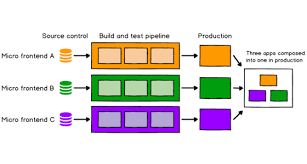
With the evolving world of enterprise software, complexity is no longer a hurdle. It’s an inherent architectural reality. As organisations deliver increasingly intricate user experiences across vast digital ecosystems, the front-end layer has become a strategic focal point. One of the most transformative trends reshaping this space is the rise of micro-frontends.
Just as microservices revolutionised back-end development by decoupling monoliths into smaller, independently deployable services, micro-frontends apply the same principle to the user interface. This approach decomposes the front end into individual components, each owned by an autonomous team, which is responsible for a specific feature or module.
Why Micro-Frontends Matter in Enterprise Portals
Enterprise portals typically span multiple domains, including HR, finance, customer management, reporting, and more. These platforms often serve diverse user bases with distinct workflows and expectations. Maintaining a monolithic UI in this context becomes a bottleneck, which hinders flexibility and delays releases.
Micro-frontends offer a solution by enabling:
- TeamFrontendy: Front-end teams can work in parallel on different parts of the application without stepping on each other’s toes.
- Faster releases: Independent deployment pipelines allow for quicker iteration and feature delivery.
- Tech stack flexibility: Teams can choose the technologies that best suit their component without being bound to a single framework.
- Ease of scaling: Applications grow organically, allowing enterprises to scale their UI in lockstep with business requirements.
Key Components of Micro-Frontend Architecture
1. Fragmentation with Purpose
Each micro-frontend handles a specific function, such as authentication, analytics, or search, and can be developed, tested, and deployed independently.
2. Container or Shell Application
This acts as the host that orchestrates the different micro-frontends. It provides routing, shared services (like global state or user sessions), and integrates disparate modules into a cohesive experience.
3. Technology Agnosticism
Micro-frontends can be built using different frameworks, such as React, Angular, and Vue, as long as they adhere to shared integration contracts and communication protocols.
4. Inter-Component Communication
Micro-frontends communicate via events or shared services. Best practices include using a publish-subscribe model to decouple modules and reduce dependencies.
5. CI/CD for Independence
Every micro-frontend should have its version control system, build pipeline, and deployment process. It empowers teams to ship features or fixes independently.
Benefits for Enterprise-Scale Platforms
- Improved Developer Experience: Smaller codebases reduce cognitive load. Developers can onboard faster and maintain clearer ownership.
- Gradual Modernisation: Enterprises can refactor outdated UI components incrementally instead of rewriting entire platforms.
- Increased Resilience: Isolating failures within a single component minimises risk to the entire application.
- Optimised Performance: Micro-frontends can be lazy-loaded as needed, improving perceived load times and user responsiveness.
Real-World Applications
- Financial Services: Banks use micro-frontends to deliver modular experiences for loan applications, transaction histories, and investment tools.
- E-Commerce: Online retailers segment their product browsing, cart, and checkout flows into distinct components to accelerate feature delivery.
- Healthcare: Patient portals leverage micro-frontends to isolate appointment booking, medical records, and billing information.
Challenges to Consider
While micro-frontends offer agility, they introduce challenges in shared state management, styling consistency, and performance optimisation. Enterprises must adopt standardised design systems and enforce architectural governance to ensure seamless user experiences.
The Road Ahead
Micro-frontends are redefining how front-end scalability and team collaboration are approached. As more organisations embrace composable architecture and agile delivery models, micro-frontends provide the building blocks for adaptable, resilient, and user-centric digital experiences.
Whether you’re modernising a legacy portal or building a new platform from scratch, micro-frontends are a powerful tool for engineering teams looking to move fast, scale safely, and meet the diverse needs of enterprise users.

Leave a Reply